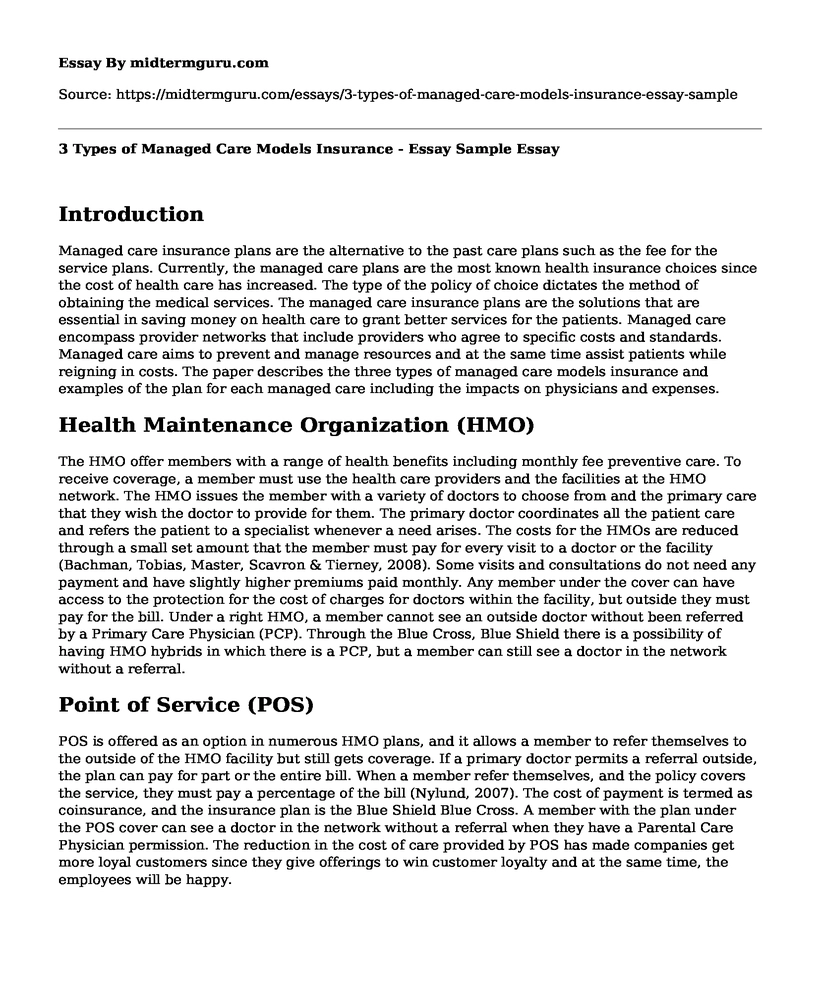Introduction
Managed care insurance plans are the alternative to the past care plans such as the fee for the service plans. Currently, the managed care plans are the most known health insurance choices since the cost of health care has increased. The type of the policy of choice dictates the method of obtaining the medical services. The managed care insurance plans are the solutions that are essential in saving money on health care to grant better services for the patients. Managed care encompass provider networks that include providers who agree to specific costs and standards. Managed care aims to prevent and manage resources and at the same time assist patients while reigning in costs. The paper describes the three types of managed care models insurance and examples of the plan for each managed care including the impacts on physicians and expenses.
Health Maintenance Organization (HMO)
The HMO offer members with a range of health benefits including monthly fee preventive care. To receive coverage, a member must use the health care providers and the facilities at the HMO network. The HMO issues the member with a variety of doctors to choose from and the primary care that they wish the doctor to provide for them. The primary doctor coordinates all the patient care and refers the patient to a specialist whenever a need arises. The costs for the HMOs are reduced through a small set amount that the member must pay for every visit to a doctor or the facility (Bachman, Tobias, Master, Scavron & Tierney, 2008). Some visits and consultations do not need any payment and have slightly higher premiums paid monthly. Any member under the cover can have access to the protection for the cost of charges for doctors within the facility, but outside they must pay for the bill. Under a right HMO, a member cannot see an outside doctor without been referred by a Primary Care Physician (PCP). Through the Blue Cross, Blue Shield there is a possibility of having HMO hybrids in which there is a PCP, but a member can still see a doctor in the network without a referral.
Point of Service (POS)
POS is offered as an option in numerous HMO plans, and it allows a member to refer themselves to the outside of the HMO facility but still gets coverage. If a primary doctor permits a referral outside, the plan can pay for part or the entire bill. When a member refer themselves, and the policy covers the service, they must pay a percentage of the bill (Nylund, 2007). The cost of payment is termed as coinsurance, and the insurance plan is the Blue Shield Blue Cross. A member with the plan under the POS cover can see a doctor in the network without a referral when they have a Parental Care Physician permission. The reduction in the cost of care provided by POS has made companies get more loyal customers since they give offerings to win customer loyalty and at the same time, the employees will be happy.
Preferred Provider Organization (PPO)
A PPO is an example of a managed care synonymous to a free for service situation. The care providers and health physicians decrease the fee from the insurer for their services so that they become part of the PPO network. The situation allows for a reduction in costs compared to going outside the system (Bachman, Tobias, Master, Scavron & Tierney, 2008). The members of the plan also have the right to refer themselves to the doctors outside the plan. A Point of Service plan is a hybrid for the PPO, and the members can designate an internal physician to be their primary care provider but also allowed to go outside for health care services. Reduction in fees enables public payers to save money by reducing their costs without any risk of blocking access to the facility.
Conclusion
In conclusion, the three managed care models insurance include Health Maintenance Organization (HMO), Point of Service (POS) and Preferred Provider Organization (PPO). Every managed care has an insurance plan that allows for the access of services outside the network at a reduced cost. The reduction in cost provided by the plans increases the quality of care, increased savings and ease of access to services outside the network.
References
Bachman, S. S., Tobias, C., Master, R. J., Scavron, J., & Tierney, K. (2008). A Managed Care Model for Latino Adults With Chronic Illness and Disability: Results of the Brightwood Health Center Intervention. Journal of Disability Policy Studies, 18(4), 197-204. https://doi.org/10.1177/1044207307311304
Nylund, L. N. (2007). ASES develops new managed care model for Medicare Platino. Caribbean Business, 35(50), 7. Retrieved from http://search.ebscohost.com/login.aspx?direct=true&db=bth&AN=28038972&site=ehost-live
Cite this page
3 Types of Managed Care Models Insurance - Essay Sample. (2022, Aug 18). Retrieved from https://midtermguru.com/essays/3-types-of-managed-care-models-insurance-essay-sample
If you are the original author of this essay and no longer wish to have it published on the midtermguru.com website, please click below to request its removal:
- Business Ethics Reflection Paper
- Influencing Factors of Life Insurance Premium Income at Home and Abroad
- Research Paper on Youth Leadership Effects on Children Development
- Research Paper on Insulin Suppression Feedback and p13K Inhibitors
- Collective Leadership and Strategic Change in Healthcare Organizations - Essay Sample
- What I Learned as a Family Nurse Practitioner - Reflection Essay
- Common STDs: Causes, Symptoms & Prevention - Essay Sample







